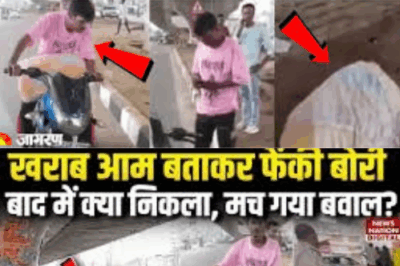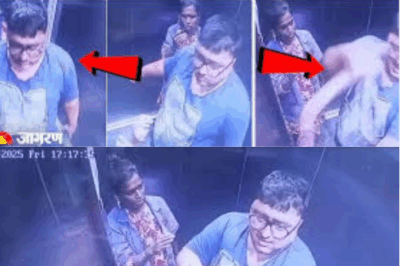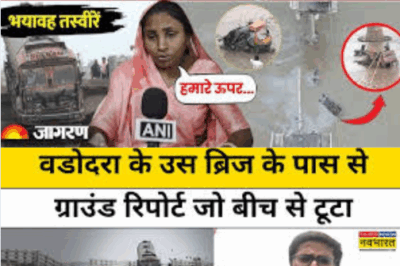Gujarat Bridge Collapse: The bridge connecting Vadodara-Anand collapsed, what did the policeman say?
In the early hours of July 9th, 2025, a catastrophic event unfolded on the bridge connecting Mujpur and Gambhira in Gujarat, India, sending shockwaves through the local community and the nation at large. Around 7:30 am, news broke that a significant portion of the bridge, a slab measuring approximately 10 to 15 meters, had collapsed and plunged into the Mahisagar River below. This bridge, an essential thoroughfare for both local residents and heavy commercial traffic, instantly became the scene of tragedy and chaos.
At the time of the collapse, two vehicles were reportedly stranded on the remaining part of the bridge, while two trucks, two pickup vehicles, and an auto-rickshaw fell into the river along with the debris. The suddenness of the incident left little time for drivers and passengers to react. Within moments, the bridge that once symbolized connectivity and progress had become a symbol of devastation, its broken span jutting out over the river, vehicles submerged or floating in the water, and bystanders rushing to comprehend the magnitude of what had just occurred.
Local residents, many of whom witnessed the disaster or arrived at the scene soon after, were among the first to respond. Alongside them, rescue teams sprang into action with remarkable speed. The initial rescue operation was a combined effort involving the local administration, the National Disaster Response Force (NDRF), fire services, and police teams from both Anand and Vadodara districts. These teams coordinated their efforts, deploying boats and divers into the river to search for survivors and recover bodies, while others worked to clear debris and secure the area.
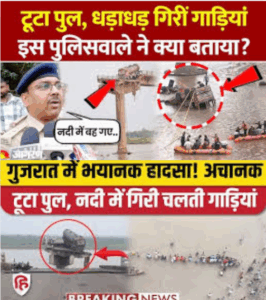
As the rescue operation unfolded, the grim reality of the accident began to emerge. According to the latest reports from authorities on the ground, nine people lost their lives in the collapse, their bodies recovered from the river and taken to Padra CSC Hospital for further procedures. In addition, nine individuals were successfully rescued from the river, five of whom were referred to SSG Hospital for further medical attention. Fortunately, none of the rescued victims were reported to be in critical condition, a small solace in the face of such a devastating event.
However, the situation remained tense and uncertain. Officials noted that two trucks were still submerged in the river and it was suspected that more people might be trapped inside these vehicles. Only after a thorough check of the vehicles would the authorities be able to provide a definitive account of the number of casualties. The rescue operation, therefore, continued with urgency, as teams combed through the wreckage and the riverbed, determined to save any remaining survivors and recover those who had perished.
Traffic management quickly became a major concern in the aftermath of the collapse. The bridge was a crucial link between Anand and Vadodara, serving as a primary route for both light and heavy vehicles, and connecting the Saurashtra region with the rest of Gujarat. With the bridge now unusable, traffic was immediately diverted to the Sindh Road bridge, but this alternative route was suitable only for light vehicles due to its own structural limitations. Heavy commercial vehicles were prohibited from using the Sindh Road bridge, and authorities began coordinating with the Bharuch and Anand air stations to divert heavy traffic through the highway, particularly via the Vasad toll route. This redirection of traffic inevitably led to congestion and logistical challenges, as the volume of vehicles on alternate routes surged.
The administrative response to the disaster was swift and comprehensive. Both Anand and Vadodara district administrations mobilized their resources, prioritizing the rescue operation above all else. The immediate goal was clear: to save lives and recover bodies from the river and the debris. The coordination between different agencies, including the NDRF, fire services, and local police, was critical in ensuring that the rescue work proceeded efficiently and safely. The authorities also took steps to secure the site and prevent further accidents, particularly as the risk of additional structural failure or debris collapse remained present.
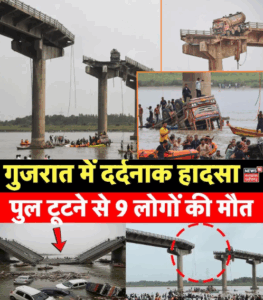
As the day progressed, officials provided regular updates to the public and the media. They confirmed that the rescue operation was ongoing and that the first priority remained the completion of the rescue and recovery work. The authorities also addressed the issue of traffic management, explaining the restrictions placed on heavy vehicles and the measures taken to ensure the smooth flow of light vehicles on the alternate routes. The district administration emphasized that arrangements had been made to handle the increased traffic volume on the Vasad route and that every effort was being made to minimize inconvenience to commuters.
The collapse of the bridge also brought to light broader concerns about infrastructure maintenance and public safety. Local residents and community leaders pointed out that the bridge had shown signs of wear and deterioration prior to the collapse. There had been calls for repairs and maintenance, but these warnings had not been adequately addressed. The disaster thus raised urgent questions about the adequacy of inspection protocols, the allocation of funds for infrastructure upkeep, and the overall prioritization of public safety in the region.
In response to these concerns, the authorities announced that a thorough investigation would be conducted to determine the cause of the collapse. A high-level committee, including experts from the roads and construction departments, was tasked with conducting a technical assessment of the incident. Their mandate was to identify any lapses in maintenance or oversight and to recommend measures to prevent similar tragedies in the future. The investigation was expected to shed light on whether the collapse was due to structural failure, negligence, or other factors.
The human cost of the disaster was deeply felt throughout the community. Families mourned the loss of loved ones, and survivors recounted harrowing tales of escape and rescue. The images of the broken bridge, the submerged vehicles, and the frantic rescue efforts were seared into the collective memory of the region. The tragedy served as a stark reminder of the fragility of life and the unpredictable nature of disaster, as well as the importance of preparedness and vigilance.
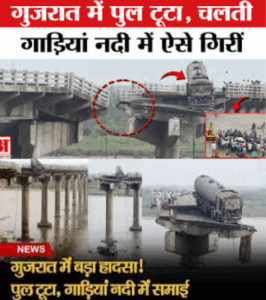
Local and national leaders expressed their condolences and support for the victims and their families. The government announced financial assistance for those affected, including compensation for the families of the deceased and aid for the injured. These gestures, while important, could not undo the pain and loss experienced by the community, but they did offer some measure of relief and reassurance.
As the rescue and recovery efforts continued, attention turned to the broader implications of the disaster. The collapse of such a vital bridge underscored the need for regular and rigorous inspection of public infrastructure, especially those structures that are decades old and bear heavy daily traffic. It also highlighted the importance of responsive governance, where warnings and requests for repairs are acted upon promptly and effectively, rather than being delayed by bureaucracy or budget constraints.
The tragedy also prompted a reevaluation of emergency response protocols. The swift mobilization of rescue teams and the coordination between different agencies were commendable, but the disaster revealed the challenges of managing large-scale emergencies in regions with aging infrastructure and limited resources. The experience gained from this incident was expected to inform future preparedness and response strategies, ensuring that authorities are better equipped to handle similar situations in the future.
In the days following the collapse, the community of Vadodara, Anand, and the surrounding areas came together in solidarity. Volunteers assisted rescue teams, local businesses provided supplies and support, and citizens offered their prayers and condolences to the victims and their families. The disaster, while devastating, also brought out the resilience and compassion of the people, demonstrating their ability to unite in the face of adversity.
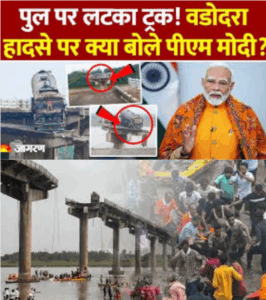
Looking ahead, the legacy of the bridge collapse will be measured not only in terms of the lives lost and the damage done, but also in the lessons learned and the changes implemented. The incident has served as a wake-up call for authorities, engineers, and the public alike, highlighting the urgent need for investment in infrastructure maintenance, transparent governance, and a culture of safety and accountability. Only through sustained effort and commitment can such tragedies be prevented in the future, ensuring that the bridges and roads that connect communities are not only symbols of progress, but also of safety and reliability.
As the community mourns its losses and begins the process of healing, the hope is that the pain and sorrow of this disaster will lead to meaningful change. The memory of those lost in the bridge collapse will endure, serving as a reminder of the cost of neglect and the importance of vigilance. Through collective action and a renewed focus on public safety, the people of Gujarat can honor the victims by building a safer and more secure future for all.
Play video :
News
Sad News as Aishwarya Sharma brokedown after Neil Bhatt’s 2nd Marriage after her DIVORCE !
Sad News as Aishwarya Sharma brokedown after Neil Bhatt’s 2nd Marriage after her DIVORCE ! The world of Indian television…
Bihar News: Something strange happened in Rahul’s rally! Pappu Yadav and Kanhaiya were insulted? What did PK say?
Bihar News: Something strange happened in Rahul’s rally! Pappu Yadav and Kanhaiya were insulted? What did PK say? The recent…
After the blue drum, the body of a girl was found in a sack in Ludhiana, thrown on the road saying that the mango was rotten
After the blue drum, the body of a girl was found in a sack in Ludhiana, thrown on the road…
Mumbai Thane Life Video: Friend’s father got angry because the lift door was closed, slapped the 12 year old child
Mumbai Thane Life Video: Friend’s father got angry because the lift door was closed, slapped the 12 year old child…
Gujarat Bridge Collapse Update: Horrific pictures of the bridge accident in Vadodara, eyewitness told the whole story
Gujarat Bridge Collapse Update: Horrific pictures of the bridge accident in Vadodara, eyewitness told the whole story On July 9,…
Can Yaman’dan Demet’e duygusal sözler: “Senin için sadece saçımı değil, canımı da veririm.”
Can Yaman’dan Demet’e duygusal sözler: “Senin için sadece saçımı değil, canımı da veririm.” . . . Can Yaman’dan Demet’e Duygusal…
End of content
No more pages to load



